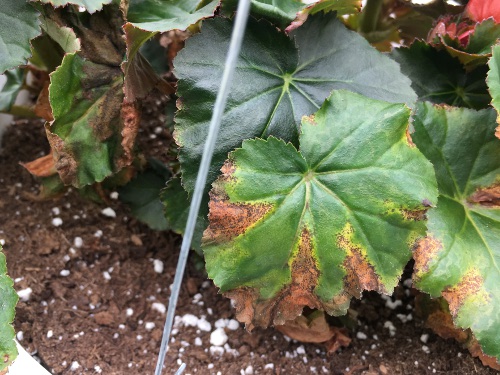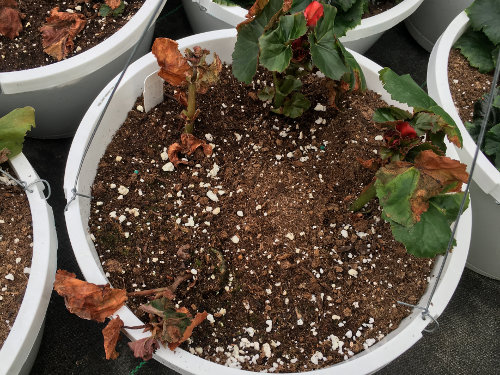Essential concepts for managing Xanthomonas in begonia — Part 1
Xanthomonas in begonia: What it is, what it does and how to know if your plants have it.

Michigan State University Diagnostic Services recently received numerous samples of begonias with Xanthomonas axonopodis pv. begonia. Many greenhouse growers are asking questions about the biology of the bacteria, how it spreads in the crop, how to minimize losses and how to sanitize after finding plants with the bacterial leaf spot. In this three-part series, we will cover these questions.
Xanthomonas is the name of a group of bacterial species, some of which cause diseases in plants. These species are often further separated into strains (called pathovars or "pv.") that indicate the specific group of plants each one attacks. Each type of Xanthomonas has a specific host, or group of related hosts, that it can infect. As the name suggests, Xanthomonas axonopodis pv. begonia is the pathovar that infects begonias. Therefore, this bacterial pathogen cannot be spread to other crops prone to Xanthomonas, such as geraniums.
How infection happens
Pathogenic bacteria usually enter a plant through a wound or natural opening (e.g., stomata). Xanthomonas bacteria are motile and equipped to move through water under their own power. When plants are wet, standing water can form a continuous pathway that extends from the outside of the leaf to the inside of the leaf through natural stomatal openings (or wounds).
The average size of a Xanthomonas bacterial cell is much smaller than most stomatal openings, so when the leaves are wet, the bacteria can literally swim into the plant (yikes!). Accordingly, the risk of bacterial infection is higher when plants are wet than when they are dry. Once inside the plant, the bacterial cells reproduce within the spaces between plant cells. With time, these bacteria can enter vascular tissue and become systemic.
In a commercial production setting, splashing water from overhead irrigation by hand-watering, irrigation booms, misting or sprinklers can efficiently spread the pathogen throughout the crop. In addition, water dripping off Xanthomonas-infected begonias in hanging baskets can spread the pathogen to begonias growing below. Therefore, growers should remove any non-infected begonias from under infected-begonia hanging baskets. Finally, a low level of disease spread has been shown to occur in water within ebb-and-flow or flood irrigation systems.
While water is the primary means of dispersal, the bacteria can also be carried to healthy plants by pruning tools, hands and clothes, animal pets, insects and even the wind.
Impact
Xanthomonas causes leaf spots and blight (Photos 1 and 2). These symptoms may not present themselves until months after the initial infection.
- Leaf spots are often small and looked water-soaked. Eventually the spots run together and coalesce into a larger splotch.
- Blight areas can have a somewhat undefined edge with a yellow halo and speckled with spots.
- Blight lesions are often V-shaped (Photos 1 and 2).

Photo 2. V-shaped lesions with yellow halo and spots from Xanthomonas.
These unsightly lesions often render the plant unsalable. In some types of begonias, the symptoms grow more severe until leaves fall off and the plant wilts and dies (Photo 3).

Photo 3. Advanced progression of Xanthomonas symptoms (leaf drop, wilt) in Reiger begonia.
Diagnosis
It's important to obtain a positive identification of any pathogen for a couple of reasons:
- Management protocol and prognosis may vary from one disease to another.
- Other involved parties may require a positive lab diagnosis for records and accounting.
Positive identification can be confirmed by sending a sample to a diagnostics laboratory. Depending on the lab, the testing process will employ culturing of the pathogen, ELISA or PCR-based methods. Test strips used to test for Xanthomonas in geraniums cannot be used to test for the Xanthomonas that infects begonias.
Please note: If the situation involves crop insurance claims or the legal system, you will need documentation from a reputable lab. Many, if not all, land-grant universities provide plant diagnostic services to growers. Don’t hesitate to contact your local Extension office for more details—we’re ready to help!
Continue to Part 2 of this Michigan State University Extension article series for suggestions on cultural practices and chemical treatments.



 Print
Print Email
Email


